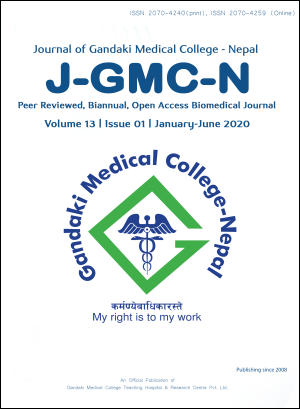Establishing surface projection of Temporo- Mandibular Joint using tragus of ear as landmark
DOI:
https://doi.org/10.3126/jgmcn.v13i1.29315Keywords:
surface projection, temporo-mandibular joint, tragus of earAbstract
Introduction: The temporo-mandibular joint (TMJ) is a synovial joint between the articular fossa of the temporal bone and the mandibular condyle. It is condylar variety of joint. The most important functions of the TMJ are mastication and speech and are of great interest to anatomists, dentists, orthodontists and oro-maxillo-facial surgeons. The study was conducted with objective to establish the surface projection of Temporo-mandibular joint (TMJ) using tragus of ear as land mark.
Materials and methods: Twenty five cadavers dissected in pre auricular area on both right and left side were studied. Out of 25 cadavers, 18 were male and seven were females. The temporo-mandibular joints were exposed on both sides, keeping the tragus of the ear intact. Altogether fifty temporo-mandibular joints were studied. On living persons, condylar head of TMJ were palpated while the subjects were carrying out side to side movement of lower jaw. The distance between the summit of the tragus and the marking on condylar head was measured with the help of divider and scale.
Result: The mean distance in millimeter (mm) from midpoint of condylar head to the summit of tragus in all living subjects and cadavers (n=150) was 12.5 ± 3.5 mm and the mean length of distal phalanx of fore finger in all living subjects and cadavers (n=150) was 22 ± 4 mm.
Conclusion: The mandibular condyle can be palpated at 12.5 ± 3.5 mm distance from summit of tragus of ear (i.e. Half-length of distal phalanx of fore finger which is 22 ± 4 mm) just below the inferior border of zygomatic arch.
Downloads
Downloads
Published
How to Cite
Issue
Section
License
This license allows reusers to distribute, remix, adapt, and build upon the material in any medium or format for noncommercial purposes only, and only so long as attribution is given to the creator.




